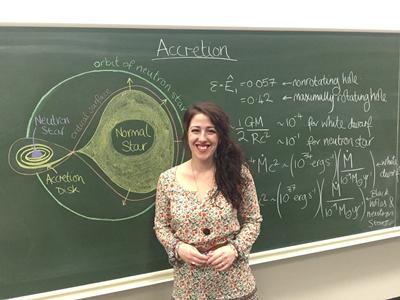Southampton Astrophysicist to present her research in Parliament

Emma Osborne, a postgraduate research student in Mathematical Sciences, has been shortlisted from hundreds of candidates for the final of the national STEM for Britain competition. The final takes place at Parliament on 13th March where she will present her research to politicians and expert judges.
The research she will show focuses gravitational waves from neutron star mountains.
Neutron stars are formed when a star dies and its core is crushed inwards, compacting its protons and electrons in a supernova explosion. A star 1.5 times the size of the sun would be squashed down to the size of the city of Southampton. They are the densest matter in the Universe and one teaspoon of a neutron star would be heavier than Mount Everest. This extreme environment makes them the perfect laboratory to test the fundamental laws of physics and drive technological advancements.
The strong gravitational pull from a neutron star rips matter from neighbouring stars onto its surface in a process called accretion; the angular momentum of the matter falling onto the surface at different angles makes the neutron star spin at increasing speeds (known as “Spinning Up”). Whilst experts expect accreting neutron stars to rotate at varying frequencies up to 1500 Hertz, most of those observed only spin at around 500 or 600 hertz so they are losing energy somehow. Emma’s research is looking at why this can be the case.
Neutron stars could be losing energy by radiating gravitational waves – ripples that travel at the speed of light, stretching and squeezing both space and time. A neutron star would not produce these waves as a perfect sphere so it must develop some form of asymmetry
Neutron stars might be deforming by growing mountains.
A mountain would form on a neutron star when the matter pulled in from other stars compacts as it moves deeper inside, creating onion-like layers within the crust, each layer having a different density.
Emma is looking to determine if “hot spots” exist within the neutron star that would cause the density distribution across these layers to become uneven and form mountains.
How hot must hot spot be?
Current estimates are that a hot spot needs to be just 1% hotter than the background temperature to produce a mountain. Emma is now investigating how a neutron stars magnetic field influences the temperature distribution in a neutron star through its interactions with the electrons in its crust and whether this could produce a hot spot at the required temperature.
On presenting her research in Parliament, she said:
‘This is an amazing opportunity to present my research to policy makers as well as increase the visibility of women in science, particularly in a field where women are hugely underrepresented.'
Emma is a passionate communicator who uses social media channels (with over 40k instagram followers and a YouTube channel) to make science accessible to everyone, with a particular focus on targeting younger teenagers. Emma was inspired to become a science communicator due to her own experiences growing up. When Emma was a young teenager herself she noticed there weren’t any female physicist role models. Almost 20 years later, and things haven’t really changed, except now Emma is in the unique position to fill this gap herself.
Emma’s research has been entered into the mathematical sciences session of the STEM for Britain competition which will end in a gold, silver and bronze prize-giving ceremony, judged by leading academics.
The Parliamentary and Scientific Committee runs the event in collaboration with the Royal Academy of Engineering, the Royal Society of Chemistry, the Institute of Physics, the Royal Society of Biology, The Physiological Society and the Council for the Mathematical Sciences, with financial support from the Clay Mathematics institute, United Kingdom Research and Innovation, Warwick Manufacturing Group, Society of Chemical Industry, the Nutrition Society, Institute of Biomedical Science the Heilbronn Institute for Mathematical Research, and the Comino Foundation.
